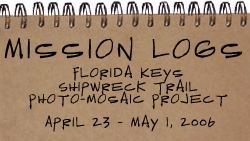|
 |
| |
Mission Logs
 April 30, 2006 April 30, 2006
Crunching data, wrapping up and heading home.
 April 29, 2006 April 29, 2006
Rough seas and small craft advisories make the going tough.
 April 28, 2006 April 28, 2006
The team explores the North America, a 19th century masted vessel.
 April 27, 2006 April 27, 2006
Today kicked off media day as the team provides an educational tour under water.
 April 26, 2006 April 26, 2006
Archaeologists kick off the photo-mosaic mission. Take a look at the newly developed sled technology in action!
Mission Home Page
|
|
|
|
Mission Log: April 28, 2006
Walter Bonora, Writer
NOAA National Marine Sanctuary Program
The morning began with a resounding “Arrrgg,” followed by a thundering, “Wake up ya bottom feeders!” Skipper Stephen Beckwith’s vocal blast got us all out of our bunks in short order. It reminded me of Quint, the colorful shark fisherman from the film Jaws.
 |
| Click image for caption and full view. |
We set out under pure sunshine and comfortable temps. Our destination - what most archaeologists and historians believe to be the wreckage of North America, a 19th century, three-masted, square-rigged vessel. Not much remains of the wooden ship, worn away by time, salt and storms.
This common fact about ships lost at sea gave pause for Russ Green to comment on the difference between wrecks in fresh water, and those in the ocean.
“Working in the Florida Keys National Marine Sanctuary really gives me an appreciation for their maritime heritage resources and the range of resources across the entire sanctuary program,” says Green. “Shipwrecks in Thunder Bay National Marine Sanctuary, where I work, are well preserved by Lake Huron’s cold, fresh water and that’s the attraction for divers and snorkelers. In the Florida Keys NMS the shipwrecks—and their stories—span several more centuries than in the Great Lakes. The wrecks here are also habitats for an incredible diversity of marine life, which adds a fascinating dimension for divers. Both sanctuaries are special places. It’s important that we continue to develop ways for both divers and non-divers to enjoy these sites. Photomosaics are a great way to do that.”
 |
| Click image for caption and full view. |
And on a humorous note, Russ couldn’t help notice the difference in gear. “In the Great Lakes we wear dry suits. Down here the only thermal protection we need is sunscreen."
The North America is a perfect example of a vessel destroyed by ship worms and the forces of nature. Yet it left a lasting impression on us as one can’t help wonder about the lives and stories of the men who manned these ships of a bygone era.
|



